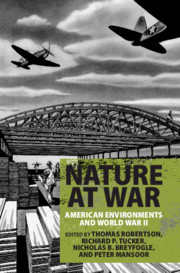Book contents
- Nature at War
- Nature at War
- Copyright page
- Contents
- Figures
- Tables and Charts
- Maps
- Contributors
- Preface
- Acknowledgments
- Introduction
- Part I New Weapons, New Spaces
- Part II Military Materials I (metals and energy)
- Part III Military Materials II (foods and plants)
- 5 Soldiers of the Soil
- 6 When Meals Became Weapons
- 7 From Field to Foxhole
- Part IV New Landscapes
- Part V New Frontiers
- Part VI Conservation
- Index
6 - When Meals Became Weapons
American Food in World War II
from Part III - Military Materials II (foods and plants)
Published online by Cambridge University Press: 25 March 2020
- Nature at War
- Nature at War
- Copyright page
- Contents
- Figures
- Tables and Charts
- Maps
- Contributors
- Preface
- Acknowledgments
- Introduction
- Part I New Weapons, New Spaces
- Part II Military Materials I (metals and energy)
- Part III Military Materials II (foods and plants)
- 5 Soldiers of the Soil
- 6 When Meals Became Weapons
- 7 From Field to Foxhole
- Part IV New Landscapes
- Part V New Frontiers
- Part VI Conservation
- Index
Summary
In World War II, food became a weapon. This metamorphosis was at the center of the US propaganda film Food and Magic. The film follows a trick-performing magician who teaches an audience about the new significance and transformations of American food from plow to table. While the magician praised farmers – and the new workers on farms – for creating abundance, he also stressed that food was a limited resource, one that was constantly being wasted. The magician shrank a tomato, telling the audience, “by waste … we’ve shrunk our available food supply … that’s like throwing victory into the garbage can.” The film promised hope, though, if Americans could learn to conserve food. As the film concludes, “Food fights for freedom … it is the weapon in our hands at home.”1
- Type
- Chapter
- Information
- Nature at WarAmerican Environments and World War II, pp. 176 - 196Publisher: Cambridge University PressPrint publication year: 2020



